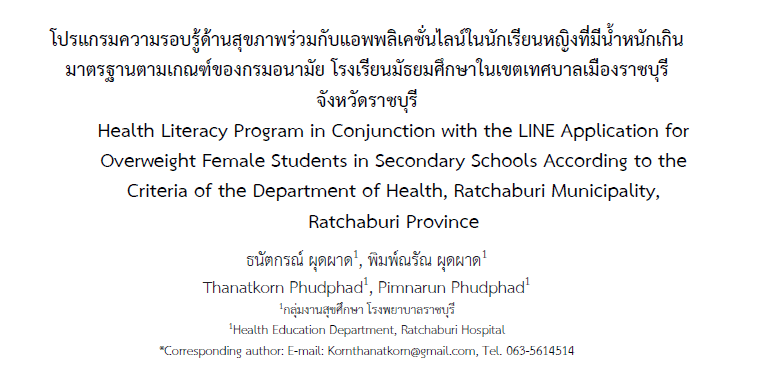Health Literacy Program in Conjunction with the LINE Application for Female Students Who are Overweight According to the Criteria of the Department of Health Secondary Schools in the District Ratchaburi Municipality, Ratchaburi Province
Abstract
This research is a two-group semi-experimental study, measuring the results before and after the experiment The Effect of the Health Literacy Program in Combination with the LINE Application on Self-Health Care Behavior to Prevent Obesity of Female Students Who Are Overweight According to the Criteria of the Department of Health. The sample was a female student who was overweight Department of Health who was studying in a municipal school. Ratchaburi Province and conducted a simple sampling. Participate in the experimental and comparison groups. The experimental group received a health literacy program with the LINE application as planned for a period of 8 weeks for 30 people, and the comparison group received usual care. 30 people The research tools include 1) a health literacy program in conjunction with the LINE application, and 2) a health literacy measure to prevent obesity. Data were analyzed with frequency, percentage, mean, standard deviation, Paired t-test and Independent t-test.
The results showed that after the experiment, the average score of health literacy in preventing obesity was statistically significantly higher than that of the control group at the level of .05 Separately, 1. Cognitive aspects of obesity prevention are different from the comparison group (p<0.002). 2. Access to information and health services for obesity prevention is different from the comparison group. (p<0.004) 3.Communication skills in obesity prevention were no different from those in the comparison group. (p<0.094) 4. Management of health conditions in the prevention of obesity is different from the comparison group. (p<0.005) 5. Media literacy in obesity prevention was different from that of the comparison group (p<0.027) and 6. No different from the comparison group (p<0.187)
After the experiment, the experimental group had a statistically significant higher average score of self-health behavior to prevent obesity than the comparison group. The results of this study show that the health literacy program in combination with the LINE application can make female students overweight exceed the standards set by the Department of Health. There is an increase in health literacy and self-health maintenance behaviors to prevent obesity.
References
กรมสนับสนุนบริการสุขภาพ กระทรวงสาธารณสุข. (2557). คู่มือประเมินความรอบรู้ด้านสุขภาพสำหรับเด็กและเยาวชนไทยที่มีภาวะน้ำหนักเกิน. สืบค้นจาก https://hed.go.th/guideline/
กรมอนามัย กระทรวงสาธารณสุข. (2560). แนวทางการคัดกรองส่งต่อและแก้ปัญหาเด็กอ้วนกลุ่มเสี่ยงในสถานศึกษา สถานบริการสาธารณสุขและคลินิก DPAC. (พิมพ์ครั้งที่3).นนทบุรี : โรงพิมพ์องค์การสงเคราะห์ทหารผ่านศึกในพระบรมราชูปถัมภ์.
กรมอนามัย กระทรวงสาธารณสุข. (2565). คู่มือหลักสูตรคลินิกไร้พุง สำหรับเจ้าหน้าที่สาธารณสุข.(พิมพ์ครั้งที่ 1). นนทบุรี : โรงพิมพ์ชุมนุมสหกรณ์การเกษตรแห่งประเทศไทย จำกัด.
ชัชวาลย์ เพ็ชรกอง, และ พรรณี บัญชรหัตถกิจ. (2562). ผลของโปรแกรมส่งเสริมความรอบรู้ด้านสุขภาพร่วมกับการใช้สื่อสังคมออนไลน์ต่อพฤติกรรมการป้องกันโรคอ้วนในนักเรียนชั้นมัธยมศึกษาปีที่ 2 ที่มีภาวะน้ำหนักเกิน.วารสารสุขศึกษา.,42 (2), 23-32.
ผลิดา หนุดละ, ปิยะนุช จิตตนูนท์, กาญจน์สุนภัส บาลทิพย์. (2560). ผลของโปรแกรมการเตือนตนเองด้านการบริโภคอาหารโดยใช้อินเตอร์เน็ตต่อพฤติกรรมการบริโภคอาหารและน้ำหนักตัวในวัยรุ่นที่มีภาวะโภชนาการเกิน.วารสารสภาการพยาบาล.; 32 : 32- 46.
ภัทราพร ทองสังข์. (2564). ผลของโปรแกรมสร้างเสริมความสามารถแห่งตนเพื่อการจัดการภาวะโภชนาการต่อพฤติกรรมการบริโภคอาหารและดัชนีมวลกายของนักเรียนชั้นมัธยมศึกษาปีที่ 5 ที่มีภาวะน้ำหนักเกิน. (พยาบาลศาสตรมหาบัณฑิต) มหาวิทยาลัยนเรศวร,พิษณุโลก.
วัชราพร เชยสุวรรณ และ อมลวรรณ ตันแสนทวี. (2561).ปัจจัยคัดสรรที่สัมพันธ์กับความรอบรู้ด้านสุขภาพของนักเรียนพยาบาลศาสตร์วิทยาลัยพยาบาลกองทัพเรือ.วารสารแพทย์นาวี, 45 (2),250-266.
สมบัติ อ่อนศิริ. (2559). ผลของการเดินโดยกำหนดเป้าหมายที่มีต่อน้ำหนักตัว เปอร์เซ็นต์ไขมัน และสมรรถภาพทางกายของนิสิตหญิงมหาวิทยาลัยเกษตรศาสตร์. วารสารพยาบาลทหารบก, 17(1), 45–53.
สุกัญญา คณะวาปี, เกศินี สราญฤทธิชัย. (2565). ผลของโปรแกรมการพัฒนาความรอบรู้ด้านสุขภาพร่วมกับโรงเรียนรอบรู้ด้านสุขภาพต่อการ ปรับเปลี่ยนพฤติกรรมเพื่อป้องกันโรคอ้วนในเด็กวัยเรียนที่มีภาวะน้ำหนักเกิน.วารสารวิชาการสาธารณสุขชุมชน.,8 (2), 105-118.
สุภาพ พุทธปัญโญ,นิจฉรา ทูลธรรม,นันทิพัฒน์ พัฒนโชติ. (2559). ประสิทธิผลของโปรแกรมพัฒนาพฤติกรรมสุขภาพต่อความฉลาดทางสุขภาพ พฤติกรรมการลดน้ำหนักและน้ำหนักของบุคลากรที่มีภาวะโภชนาการเกินในโรงพยาบาลร้อยเอ็ด อำเภอเมือง จังหวัดร้อยเอ็ด. วารสารการพยาบาลและการศึกษา,9 (4) ,42-59.
อรณิชา โพธิ์หมื่นทิพย์. (2564). ประสิทธิผลของโปรแกรมความรอบรู้ด้านสุขภาพเพื่อป้องกันโรคอ้วนของนักเรียนมัธยมศึกษาตอนต้นในอำเภอเมือง จังหวัดนครราชสีมา. สืบค้นจากhttps://www.mnrh.go.th/pdf_file_academic/academic_25640818-01.pdf
Bandura, A. (1997). Self-efficacy the exercise of control. New York: W.H. Freeman.
Faul, F., Erdfelder, E., Buchner, A., & Lang, A.-G. (2009). Statistical power analyses using G*Power 3.1: Tests for correlation and regression analyses. Behavior Research Methods, 41(4), 1149-1160.
Nutbeam, D. (2008). The evolving concept of health literacy. Social science & medicine, 67 (12), 2072-2078.
Patrick, K., Marshall, S. J., Davila, E. P, Kolodziejczyk, J.K. Fowder,J.H.,Calfas ,K.J.,... Merchant, G. (2014). Design and implementation of a randomized controlled social and mobile weight loss trial for young adults (project SMART). Contemporory Clinical Trials, 37(1), 10-18.
Sumitmaitree, B. (2003). Health Literacy Situation and Promoting Thai Health Literacy for ASEAN community. Report from DCAST: Bangkok.
Tipwong, A., & Numpon, J. (2014). The Relationship Between Health Literacy of Obesity and Eatingbehavior and Exercise in Obese Children, Bangkok. Journal of Public Health Nursing, 28 (2), 1-11.

Downloads
Published
How to Cite
Issue
Section
License
Copyright (c) 2024 Journal of Health Innovation and Safety (JHIS)

This work is licensed under a Creative Commons Attribution-NonCommercial-NoDerivatives 4.0 International License.
1. บทความหรือข้อคิดเห็นใด ๆ ที่ปรากฏในวารสารนวัตกรรมสุขภาพและความปลอดภัย ที่เป็นวรรณกรรมของผู้เขียน บรรณาธิการ ไม่จำเป็นต้องเห็นด้วย
2. บทความที่ได้รับการตีพิมพ์ถือเป็นลิขสิทธิ์ของ วารสารนวัตกรรมสุขภาพและความปลอดภัย






